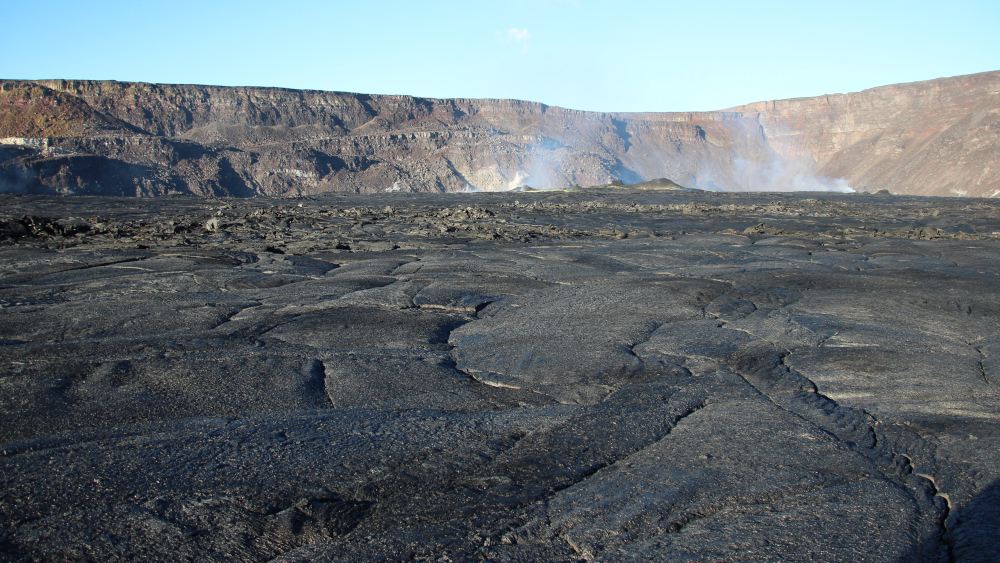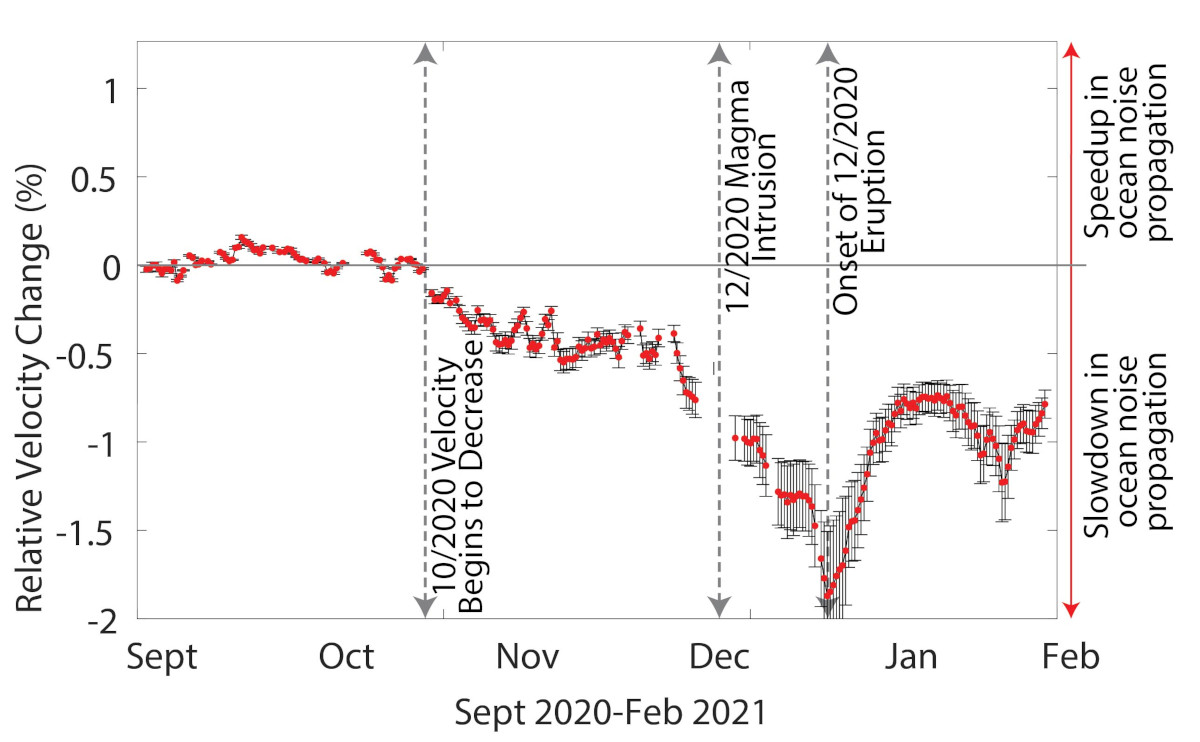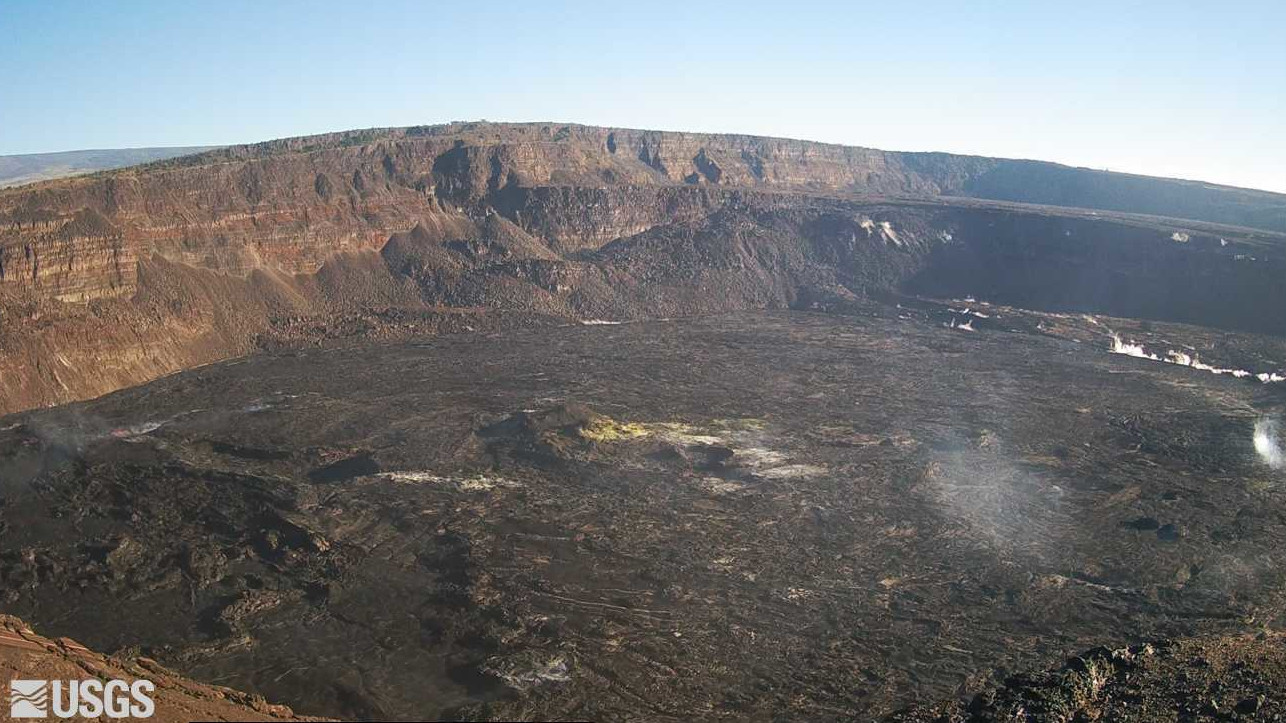
USGS: “View looking southwest across the Halemaʻumaʻu crater floor within the Kīlauea summit caldera, captured during a helicopter overflight on Thursday, June 22, 2023. Lava erupted during the most recent eruption comprises the crater floor in the bottom half of the photo. Remnants of the main island—formed during the early stages of the December 20, 2020 eruption—protrude above the cooled lava lake in the center of the photo, and the recent eruptive vent on the southwest wall of Halemaʻumaʻu is visible behind and right of the main island.” (USGS photo by N. Deligne)
(BIVN) – Kīlauea is not erupting. Scientists note earthquake activity in the summit region has increased slightly over the past week, while summit tiltmeters show gradual inflation.
The USGS Volcano Alert Level for Kīlauea remains at ADVISORY. Scientists continue to closely monitor the volcano using various tools and methods, including “ocean noise velocity”, as detailed below.
From this week’s Volcano Watch article, written by U.S. Geological Survey Hawaiian Volcano Observatory scientists and affiliates:
In climates that experience all four seasons, scientists have shown that ocean noise travels through these regions faster in times when snowpack is present and slower in times when the snow has melted. This winter speedup is due to the overlying snowpack compressing the subsurface and closing any fractures below it.
When the snow thaws, the subsurface is no longer compressed, the fractures open again, and the snow melt percolates into these fracture systems. This causes ocean noise to travel through these regions more slowly in the spring and summer months. Similarly, in climates that experience excessive rainfall, such as Hawaii, such precipitation diffuses into the ground, opening fractures and cracks, and causing slowdowns in ocean noise propagation speeds.
Magma moving under active volcanoes can cause similar opening and closing of fracture systems resulting in changes in the velocity at which ocean noise signals travel through a volcano. Scientists at the Hawaiian Volcano Observatory are developing new techniques that utilize such velocity changes to understand what is happening beneath the surface of volcanoes on the Island of Hawaiʻi.

USGS: “The figure shows changes in the propagation speed of ocean noise signals (red filled circles) through Kīlauea volcano from September 2020–February 2021. Positive values indicate a speedup in the propagation speed of ocean noise while negative values indicate a velocity slowdown. The black bar around each red circle indicates the uncertainty in the relative velocity change measurement.”
The figure shown here indicates changes in the velocity of ocean noise traveling through the summit region of Kīlauea volcano several months before, and in the month after, the start of the summit eruption in December 2020.
From September to mid-October 2020, the velocity of ocean noise in Kīlauea summit region remained fairly constant. However, by mid-October 2020, velocities in the summit region began to decrease rapidly. When magma migrates beneath the surface, it opens cracks and fractures in the region immediately above it. The opening of these fracture systems, as well as the influx of the magma itself, causes a slowdown in the propagation speed of ocean noise signals through that region.
Scientists at the Hawaiian Volcano Observatory have concluded that magma began to move from deeper depths beneath Kīlauea summit by mid-October 2020. By early December 2020, velocities began to decrease at a more dramatic rate suggesting a more rapid inflow of magma into Kīlauea summit. At that point, earthquake and ground deformation patterns beneath the summit indicated that a small intrusion of magma had occurred.
By mid-December 2020, the velocity of ocean noise traveling through Kīlauea’s summit decreased even more, indicating the continued invasion of magma into the volcano.
Finally, on December 20, 2020, at approximately 9:30 p.m. HST, the eruption at Kīlauea’s summit began. Following the onset of this eruption, as seen in the figure, a dramatic increase in the propagation speed of ocean noise signals through the summit region was observed. As magma was removed from the shallow storage reservoir, by the outpouring of lava, the region above it deflated. This deflation causes the closure of fractures within the shallow summit, and a resulting increase in the velocity of ocean noise through the summit.
This example demonstrates how monitoring for changes in ocean noise velocity could potentially be used to aid in forecasting volcanic activity. Hawaiian Volcano Observatory scientists are working to better understand this process and apply it as a real-time monitoring tool at both Kīlauea and Mauna Loa volcanoes.


by Big Island Video News7:21 am
on at
STORY SUMMARY
HAWAIʻI VOLCANOES NATIONAL PARK - Scientists examine how ocean noise velocity coincides with volcanic activity at Kīlauea.